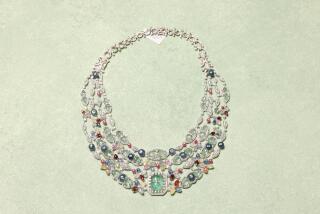Government Agency Offers Gem of a Deal
TUCSON â Want a good deal on some gems? Uncle Samâs got âem. And his prices canât be beat.
Tucked away among the hundreds of display booths at Tucsonâs recent Gem and Mineral Show was a vendor trying to fatten the American publicâs pocketbook.
The Defense National Stockpile Center was selling off synthetic gemstones that were once considered vital to the nationâs war-making ability, but no longer are needed to keep America safe.
So this obscure agency has turned entrepreneur, offering customers items once used to build lasers, or Space Age metals being peddled in plastic bags. Tiny amounts drawn from tons of mica and soapstone, synthetic ruby and white sapphire, were on display.
The materials are among stockpiled supplies of 92 commodities, from antimony to zinc, valued at more than $6 billion. The materials sold at the Tucson gem show, one of the worldâs biggest, were suitable for synthetic gemstones or for other artistic, craft and decorative uses.
Larry Venezia, a Boston construction engineer, browsed through the tent and held up a bag filled with pieces of thin, translucent mica.
âThis is actually a real good deal, a buck for this bag of absolutely clear mica. Thatâs pretty cheap,â said Venezia, who has bought and sold mineral specimens at the annual exhibition for 15 years.
âThis is the best mica you can possibly find. No one buys mica for a buck a pound. Nobody uses it any more.â
Not quite.
Once used as an insulator in vacuum tubes and toasters, artists still like to use mica in Tiffany-style lampshades. The center sold all 633 pounds of mica it shipped to Tucson. It will fill other, bigger orders directly from among its 85 depots--with one customer here having ordered 1,000 pounds.
Beryl ore, 800 pounds of it, sold out. Beryllium used in spacecraft and aircraft comes from the ore.
Other big sellers were 2,600 pounds of talc or soapstone, once used for spacers in electronic tubes and transmitting equipment. Buyers also snapped up 85 pounds of synthetic ruby and white sapphire, once used in laser and electrical applications.
âItâs done quite well. Weâve been quite pleased,â said chief of operations and logistics Mary Moyer, who headed the Tucson exhibit.
No one could argue with the prices. Green beryl sold for $10 a pound, dark blue for $15. Man-made ruby rods went for 12 cents a carat, white sapphire for 11 cents.
Venezia thought the government selling off its extras was a good idea.
âIf we donât need it, what the hell?â Venezia said.
Materials normally are sold by the truck- or barge-load, and buyers range from industrial users to artists and craftsmen.
âSelling individually is not the norm for us,â said Bob OâBrien, deputy administrator of the center, based at Ft. Belvoir, Va. âLast year, we sold in excess of $400 million in excess commodities that we brought back to the taxpayer.â
At best, its Tucson gem show sales might be a fraction of that. But two years ago in a gem show here, the center sold $3.2 million worth of quartz crystals.
Congressional oversight precludes such sell-offs from being disruptive to national or international markets, OâBrien said.
The center had no fine gem-quality diamonds, emeralds, sapphires or rubies for sale, so gem dealers had no worry about the government flooding the market.
The stockpileâs inventory does include 50-year-old industrial diamonds that could fetch $700 a carat after being cut, faceted and polished, OâBrien said.
âWe have 7,000 tons of beryl ore in the stockpile inventory, but a very small amount of that is gem quality that will bring a value to either the hobbyist or the jewelry manufacturer,â he said.
âTheyâre probably more of a novelty because they come from the defense stockpile than because of their gemological interest,â said Peggy Willett of the Dallas-based American Gem Trade Assn.
More to Read
Sign up for The Wild
Weâll help you find the best places to hike, bike and run, as well as the perfect silent spots for meditation and yoga.
You may occasionally receive promotional content from the Los Angeles Times.






